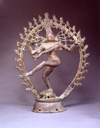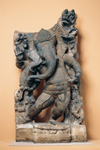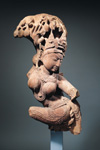| Gita Mehta | |
|
Gita Mehta was born in New Delhi, India, to a prominent political family. While attending Cambridge University she met her future husband, publisher Sonny Mehta and the couple moved to New York City in 1987. Mehta has been a television war correspondent, made several documentary films for such television companies as NBC and BBC, and is the author of four best-selling books: Karma Cola, Raj, A River Sutra, and Snakes and Ladders. Selected Objects |

(Shiva Nataraja)
India, Tamil Nadu
Chola period, about 870
Copper alloy
H. 26 3/4 in. (67.9 cm); 1979.20
Nataraja is Shiva as the Lord of the Dance, in the ananda tandava, the Dance of Bliss. A ring of flames around the god depicts the whirling energy of nature's cycles of birth and death and rebirth, a dancing cosmos brought into motion by the dancing god within, yet the wild movement of Shiva's dance is in counterpoint to the stillness of his smiling face, deep in meditative consciousness.
This is Shiva as the Destroyer and Shiva as the Destroyer of Destruction: as two forms of time - kala, temporary time, and mahakala, eternal time.
In one hand he holds a drum-symbol of the sound of Om and of the vibration which is the origin of creation. In another he holds a flame to incinerate the cosmos and permit creation of the next. A hand points to a foot dancing on a dwarf, symbolic of the evil which yokes men to the wheel of existence through heedlessness, inattention, oblivion. The raised foot offers release, through awareness, from endured time, kala, the endless cycle of rebirth. A raised hand indicates the sublime consciousness that results from union with mahakala, eternal time.
Containing the most
complex philosophical perceptions in a single simple image the Nataraja
is, for me, the defining icon of India.

India, Uttar Pradesh
8th century
Sandstone
H. 49 1/2 in. (125.7 cm); 1979.13
As the son of Shiva, Lord of the Dance, the elephant-headed Ganesha is often depicted in endearingly sensual, even humorous, dance postures, inviting devotees to approach him as the remover of obstacles. But one of Ganesha's tusks is always broken-here held aloft in a left hand-making the god particularly beloved to writers.
It is said that sitting on a riverbank a great sage dictated a poem to Ganesha. The sage's recitation continued for nights and days without pause until all Ganesha's pens had worn away. Rather than interrupt the flow of the sage's inspiration, the elephant-headed god broke off one of his tusks, dipped it into ink, and carried on writing.
With his sacrifice
Ganesha ensured that mankind would possess the longest-and to Indians,
the greatest-epic poem in human history, the Mahabharata.

India, Rajasthan or Uttar Pradesh
11th century
H. 21 1/4 in. (54.0 cm); 1979.33
Displaying the unique ability of India's master carvers to make stone appear as fluid as water, the sculptor of the celestial entertainer has taken the figure's tribhanga, or three essential curves from shoulder to waist to hip, required in classical Indian dance, and repeated it in the curve of the tree overhanging her head to create a continuous flowing movement.
A tree represents the fertility which is synonymous with divinity in India. Here it also re-enforces the fecund sensuality of the celestial entertainer's breasts and hips. The image of ripeness is further emphasized in the heavy fruit hanging in the tree above her, and the playful eroticism of two monkeys fighting over the fruit. The artist adds an elaborate head-dress, necklaces, arm-bands, bangles and girdles, all depicted with a delicacy that serves to re-enforce the dancer's curving grace.
Outside observers,
overwhelmed by the sensuality of Indian sculpture, have often expressed
moral or aesthetic censure. The indologist William Archer even described
Indian art as suffering from "gargantuan excess." But excess implies vulgarity.
Here there is no vulgarity. Only a perfect-and perfectly desirable-abundance.